人口老龄化的优缺点以及措施(英文)幻灯片
- 格式:ppt
- 大小:611.00 KB
- 文档页数:75
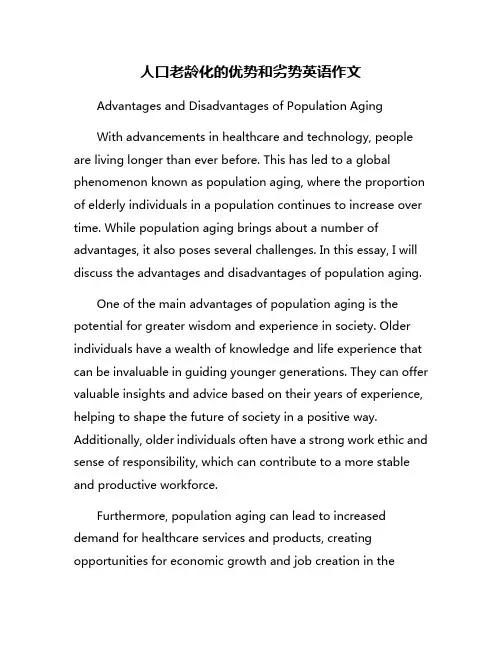
人口老龄化的优势和劣势英语作文Advantages and Disadvantages of Population AgingWith advancements in healthcare and technology, people are living longer than ever before. This has led to a global phenomenon known as population aging, where the proportion of elderly individuals in a population continues to increase over time. While population aging brings about a number of advantages, it also poses several challenges. In this essay, I will discuss the advantages and disadvantages of population aging.One of the main advantages of population aging is the potential for greater wisdom and experience in society. Older individuals have a wealth of knowledge and life experience that can be invaluable in guiding younger generations. They can offer valuable insights and advice based on their years of experience, helping to shape the future of society in a positive way. Additionally, older individuals often have a strong work ethic and sense of responsibility, which can contribute to a more stable and productive workforce.Furthermore, population aging can lead to increased demand for healthcare services and products, creating opportunities for economic growth and job creation in thehealthcare sector. The aging population requires more healthcare services, such as medical care, long-term care, and home care, which can create new job opportunities for healthcare professionals. This can also stimulate innovation in healthcare technology and services, leading to improvements in quality of care and quality of life for elderly individuals.Another advantage of population aging is the potential for intergenerational solidarity and support. As the population ages, there is a greater need for support systems that can help older individuals maintain their independence and quality of life. This can foster closer relationships between generations, as younger individuals may step in to provide care and support for their elderly relatives. This can strengthen family bonds and create a sense of unity and solidarity within the community.However, population aging also presents several challenges that need to be addressed. One of the main disadvantages is the strain it can place on social security and pension systems. With more elderly individuals relying on social security and pensions for income, there is a growing concern about the sustainability of these systems. Governments may need to make changes to social security and pension policies to ensure that they remain financially viable in the face of an aging population.Additionally, population aging can lead to a shortage of skilled workers in certain industries, as older individuals retire and there are not enough young workers to replace them. This can create challenges for businesses and industries that rely on a skilled workforce, as they may struggle to find qualified employees to fill vacant positions. This can also impact economic growth and productivity, as businesses may be unable to meet their production goals due to a lack of skilled workers.Furthermore, population aging can result in increased healthcare costs and a greater burden on the healthcare system. As the population ages, there is a greater need for healthcare services, such as medical care, long-term care, and home care. This can put a strain on healthcare resources and lead to higher healthcare costs for both individuals and governments. Healthcare systems may need to adapt and expand to meet the growing demand for services, which can be costly and challenging.In conclusion, population aging has both advantages and disadvantages that need to be carefully considered. While population aging can bring about greater wisdom, experience, and intergenerational solidarity, it can also lead to challenges such as strain on social security systems, a shortage of skilledworkers, and increased healthcare costs. It is important for governments, businesses, and communities to address these challenges and work together to create a sustainable and inclusive society for individuals of all ages.。
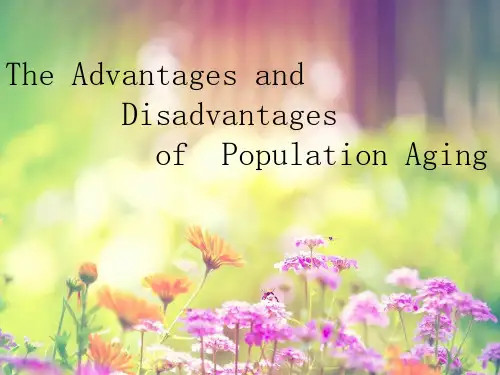
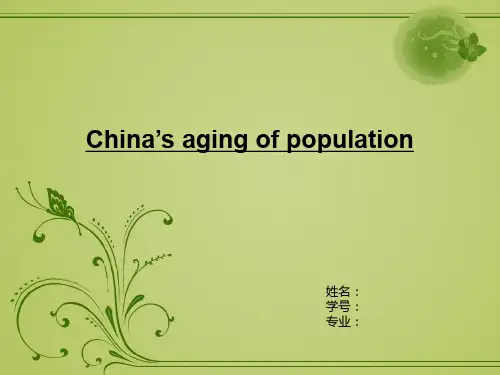


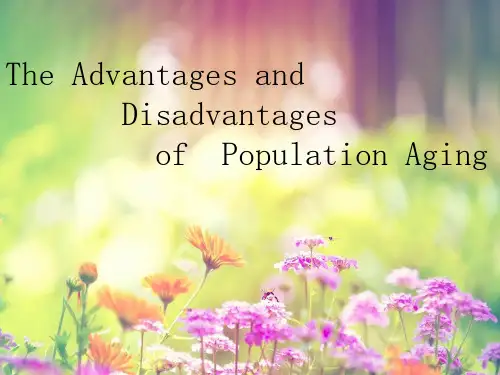
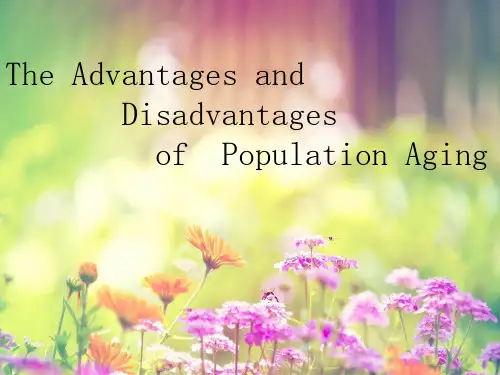
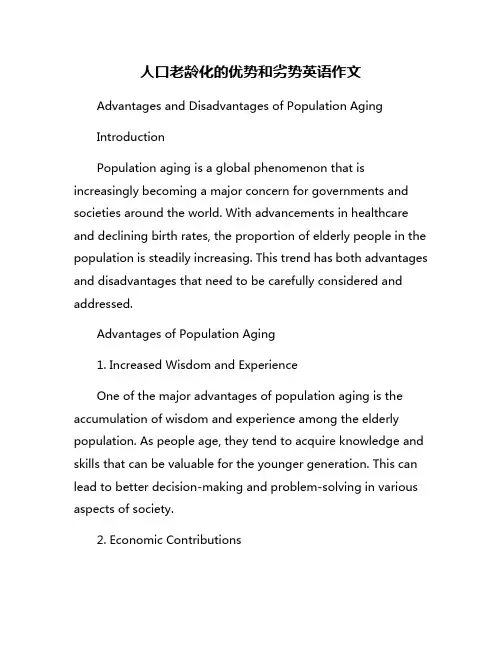
人口老龄化的优势和劣势英语作文Advantages and Disadvantages of Population AgingIntroductionPopulation aging is a global phenomenon that is increasingly becoming a major concern for governments and societies around the world. With advancements in healthcare and declining birth rates, the proportion of elderly people in the population is steadily increasing. This trend has both advantages and disadvantages that need to be carefully considered and addressed.Advantages of Population Aging1. Increased Wisdom and ExperienceOne of the major advantages of population aging is the accumulation of wisdom and experience among the elderly population. As people age, they tend to acquire knowledge and skills that can be valuable for the younger generation. This can lead to better decision-making and problem-solving in various aspects of society.2. Economic ContributionsContrary to popular belief, elderly people can still make significant economic contributions to society. Many older individuals continue to work past retirement age, either out of necessity or choice. Additionally, older people often have more disposable income, which can stimulate consumer spending and drive economic growth.3. Social CohesionPopulation aging can also lead to greater social cohesion and intergenerational bonding. As families spend more time together and support each other across different age groups, a sense of community and solidarity can be fostered. This can have positive effects on mental health and overall well-being.4. Healthcare InnovationThe aging population creates a demand for healthcare services and technologies that cater to the specific needs of elderly individuals. This can drive innovation in healthcare and lead to the development of new treatments and interventions that benefit people of all ages.Disadvantages of Population Aging1. Increased Healthcare CostsAs the population ages, the demand for healthcare services and long-term care facilities also increases. This can strain healthcare systems and lead to higher healthcare costs for both the government and individuals. Adequate funding and resources are needed to ensure that elderly people receive quality care.2. Decline in WorkforcePopulation aging can result in a decline in the working-age population, which can have negative effects on the economy. A smaller workforce may lead to labor shortages, reduced productivity, and slower economic growth. Policymakers need to implement strategies to attract and retain workers of all ages.3. Pension and Social Security ChallengesThe increase in the elderly population puts pressure on pension and social security systems, as more people rely on these programs for financial support. Without reforms and adjustments, these systems may become unsustainable in the long run, leading to economic instability and social inequality.4. Social IsolationElderly people are at risk of social isolation and loneliness, especially if they live alone or have limited mobility. This canhave detrimental effects on mental health and quality of life. Community support programs and initiatives are needed to address these social challenges.ConclusionPopulation aging comes with both advantages and disadvantages that require careful planning and proactive measures to mitigate potential risks. By recognizing and addressing the needs of the aging population, societies can harness the wisdom and experience of older individuals while ensuring their well-being and inclusion in society. Collaboration between governments, businesses, and communities is essential to build a sustainable and age-friendly society for future generations.。
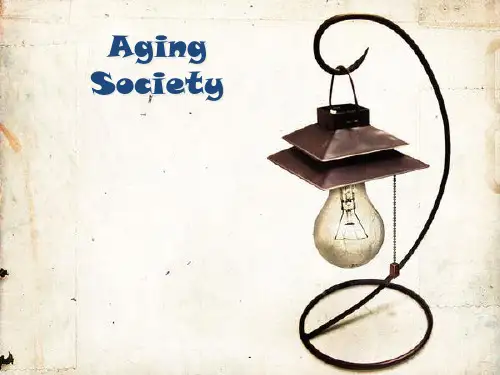
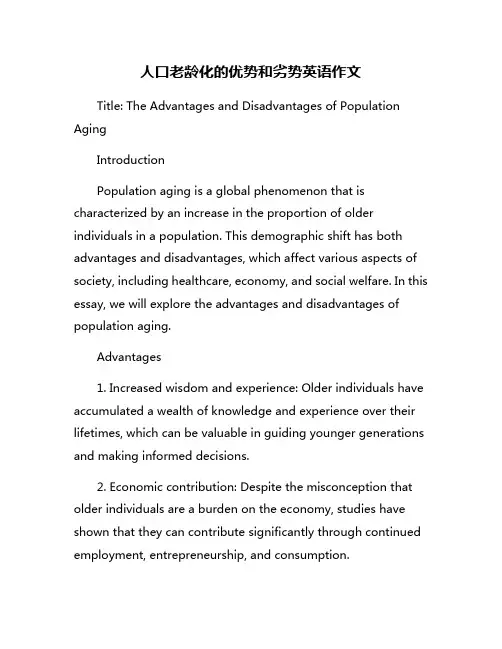
人口老龄化的优势和劣势英语作文Title: The Advantages and Disadvantages of Population AgingIntroductionPopulation aging is a global phenomenon that is characterized by an increase in the proportion of older individuals in a population. This demographic shift has both advantages and disadvantages, which affect various aspects of society, including healthcare, economy, and social welfare. In this essay, we will explore the advantages and disadvantages of population aging.Advantages1. Increased wisdom and experience: Older individuals have accumulated a wealth of knowledge and experience over their lifetimes, which can be valuable in guiding younger generations and making informed decisions.2. Economic contribution: Despite the misconception that older individuals are a burden on the economy, studies have shown that they can contribute significantly through continued employment, entrepreneurship, and consumption.3. Social cohesion: Older individuals often play a crucial role in maintaining social cohesion within communities by serving as mentors, caregivers, and volunteers.4. Innovation and creativity: Older individuals can bring a different perspective to problem-solving and decision-making, leading to more innovative solutions and creative ideas.Disadvantages1. Decline in workforce: As the proportion of older individuals in the population increases, there may be a decline in the working-age population, leading to labor shortages and reduced economic productivity.2. Increased healthcare costs: Older individuals tend to have higher healthcare needs, which can put a strain on healthcare systems and increase healthcare costs for individuals and governments.3. Pension system challenges: Population aging can strain pension systems as the number of retirees increases relative to the number of working-age individuals contributing to the system.4. Social isolation: Older individuals may face social isolation and loneliness, which can have negative impacts on their mental and physical health.ConclusionPopulation aging presents both advantages and disadvantages for society. While older individuals bring wisdom, experience, and economic contributions, they also pose challenges related to workforce decline, healthcare costs, pension system sustainability, and social isolation. It is crucial for policymakers to address these challenges and implement solutions that promote the well-being and inclusion of older individuals in society.。

人口老龄化的优势和劣势英语作文The Advantages and Disadvantages of Population AgingThe world's population is undergoing a significant demographic shift, with an increasing proportion of older adults relative to younger individuals. This phenomenon, known as population aging, has been driven by a combination of factors, including declining fertility rates and increased life expectancy. While population aging presents both advantages and disadvantages, it is a trend that will have far-reaching implications for societies and economies globally.One of the primary advantages of population aging is the wealth of experience and knowledge that older adults possess. As individuals live longer and remain active later in life, they can contribute their expertise and skills to various sectors, from business and industry to education and healthcare. This can lead to increased productivity and innovation, as older adults bring a unique perspective and deep understanding of complex issues. Moreover, the presence of a larger older adult population can foster intergenerational learning and knowledge transfer, benefiting both younger and older individuals.Another advantage of population aging is the potential for increasedsocial stability and community engagement. Older adults often have more time and resources to devote to community service, volunteering, and civic engagement. This can lead to stronger social cohesion, as older adults play a more active role in shaping their local communities. Additionally, older adults may be more inclined to participate in political processes, providing a valuable perspective and ensuring that the needs of this demographic are represented in decision-making.Population aging can also have positive implications for the healthcare sector. As individuals live longer, they may require more specialized medical care and support services. This can create new job opportunities in the healthcare industry, from geriatric nursing and gerontology to the development of assistive technologies and long-term care facilities. Furthermore, the increased demand for healthcare services can drive innovation and advancements in medical research, leading to improved quality of life and better health outcomes for older adults.However, population aging is not without its challenges. One significant disadvantage is the potential strain on social welfare systems, such as pension and retirement programs. As the proportion of older adults increases, the number of working-age individuals supporting these systems may decrease, leading to financial pressures and the need for reforms. Governments andpolicymakers will need to address these challenges through innovative approaches, such as encouraging longer working lives, promoting private retirement savings, and exploring alternative funding models.Another disadvantage of population aging is the potential burden on the healthcare system. As the older adult population grows, the demand for medical services, long-term care, and specialized treatments may exceed the capacity of the healthcare infrastructure. This can result in longer wait times, increased costs, and potential disparities in access to quality care. Addressing these challenges will require significant investments in healthcare systems, as well as the development of new models of care that prioritize the unique needs of older adults.Population aging can also have implications for the labor market. As the proportion of older workers increases, there may be a need to adapt workplace policies and practices to accommodate their needs, such as flexible work arrangements, phased retirement options, and lifelong learning opportunities. Failure to address these issues could lead to skill shortages, reduced productivity, and potential tensions between younger and older workers.Finally, population aging may have social and cultural implications, as the changing demographic landscape can influence societalnorms, values, and interactions. Intergenerational relationships and support systems may need to evolve to meet the needs of a more age-diverse population. Additionally, the increasing number of older adults may lead to shifts in consumer preferences, housing demands, and the allocation of public resources, which can have far-reaching consequences for communities and economies.In conclusion, population aging is a complex and multifaceted phenomenon that presents both advantages and disadvantages. While the wealth of experience and knowledge possessed by older adults can be a valuable asset, the potential strain on social welfare systems, healthcare infrastructure, and labor markets must be addressed through comprehensive policy interventions and societal adaptations. By proactively addressing the challenges and leveraging the opportunities presented by population aging, societies can ensure a more equitable and sustainable future for individuals of all ages.。
人口老龄化说明利弊英语作文The aging population brings both benefits and challenges to society.人口老龄化给社会带来了利弊。
One of the benefits of an aging population is the increase in wisdom and experience that older individuals bring to society.人口老龄化的一个好处是老年人带来的智慧和经验的增加。
With more elderly people in society, there is a greater pool of knowledge that can be passed down to younger generations.随着社会中年龄较大的人数增加,可以传承给年轻一代的知识也更为丰富。
Additionally, older individuals often have a strong work ethic and a sense of responsibility, which can positively influence those around them.此外,老年人通常具有较强的职业道德和责任感,这可能会对周围的人产生积极影响。
Furthermore, the elderly often contribute to society in various ways, whether through volunteering, mentoring, or other forms of community involvement.此外,老年人往往通过志愿活动,指导,或其他形式的社区参与等多种方式为社会做出贡献。
However, the aging population also presents challenges for society.然而,人口老龄化也给社会带来了挑战。